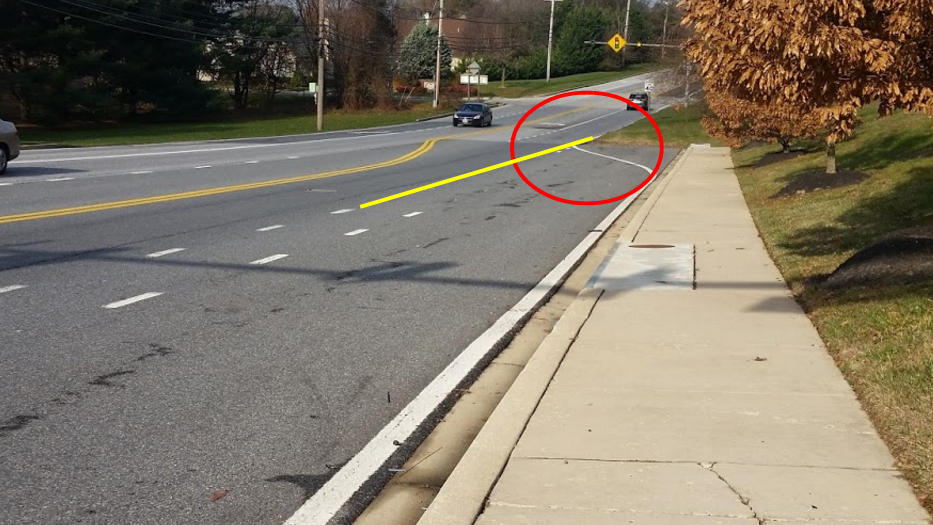What’s the Deal with Bike Lanes?
By Bruce Cohen - February 23, 2016
 MD-103, where the bike lane ends in grass.
MD-103, where the bike lane ends in grass.Maryland is one of 11 states that still requires bicyclists to use bike lanes when available. Delegate Carr’s HB 426 seeks to repeal Maryland’s mandatory bike lane use law. Several years ago Delegate Carr successfully repealed Maryland’s mandatory shoulder use law.
While bike lanes are generally good, there are many cases across the state where the lane was poorly designed. Mandatory bike lane use is an issue when the lanes are poorly designed, a situation that is not covered by one of the law’s many exceptions.
For example, during testimony I spoke about my experience with a bike lane on MD-103. For those who are not familiar with this road, MD-103 connects downtown Ellicott City into several important destinations, including shopping, schools, Rockburn Park, a MARC station, and a low-stress connection into Columbia/Elkridge. I use MD-103 to get to a Park and Ride to get into work.
MD-103 had an intersection redone a couple of years ago, and now has a “pocket lane.” These are the very short bike lanes that appear only in and around an intersection, then end. The State Highway Administration, and others, installs these very brief bike lanes with little to no attention paid to merge zones – the bike lane ends at the end of the project perimeter. Sometimes they end in shoulder, but oftentimes they end in grass. This is not a safe situation for drivers (who expect the bicyclist to have the bike lane) and for bicyclists (who suddenly have to merge). It is best for the bicyclist to maintain lane position so the drivers passing can predict their movement and trajectory. Steady and predictable is the name of the game.
In other cases, such as MD-2 through Edgewater, the bike lane is very narrow and parallel to many cutouts for business driveways. In this case, if a bicyclist has the misfortune of needing to ride here, the bike lane is not necessarily the safest place because the bicyclist is on the periphery of the road. Drivers at uncontrolled intersections and breaks in the median have to make quick decisions to cross the multi-lane road. A bicyclist at the periphery is not always noticeable.
A driver making a quick left turn over multiple lanes of traffic killed Andrew Malizio of Gaithersburg in 2014. There was no bike lane here, but Andrew was riding in the right-most lane as he was required. Drivers typically focus on the center of the lane when they check for traffic; the defensive bicyclist rides towards the center of the lane through intersections in hopes that they will catch the eye of left turning vehicles. Even still, it is no guarantee.
Maryland’s contributory negligence standard is a big part of our issue with mandatory bike lane use. Back to my example on MD-103, when can I leave that bike lane before it ends and be exempt from mandatory use? If a speeding driver comes upon me suddenly and hits me while I am outside the lane, I am at least 1% at fault and can be denied my insurance claim.
Maryland already has a ride to the right provision in the law – bicyclists have to ride as far right as is practicable and safe. In many cases, with properly designed and installed bike lanes that are continuous, bicyclists will still be required to ride in them. But the mandatory bike lane use law prevents a bicyclist from using their discretion on which lane position is safest for them in those conditions that day.
Bike Maryland is working with SHA on their bike lane standard. Bike lanes can be great, but when installed inappropriately (especially when combined with mandatory use), that’s an issue.
Share
Tweet